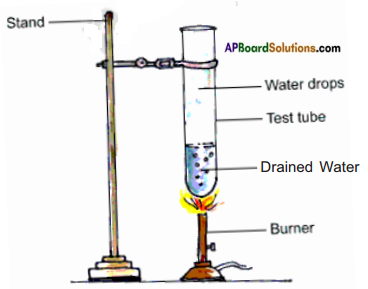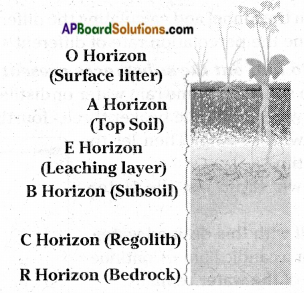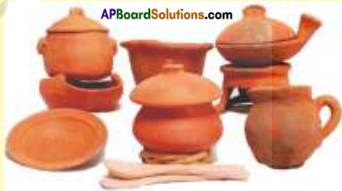AP State Syllabus AP Board 7th Class Science Important Questions Chapter 15 Soil: Our Life
AP State Syllabus 7th Class Science Important Questions 15th Lesson Soil: Our Life
7th Class Science 15th Lesson Soil: Our Life Important Questions and Answers
Question 1.
Describe the distinct horizontal layers of the soil. What are these layers made up of (or) Describe the soil profile.
Answer:
Soil is made up of distinct horizontal layers. These layers are called horizons. They range from rich, organic upper layers (humus and topsoil) to underlying rocky layers (subsoil, regolith and bedrock).
- O Horizon – The top, organic layer of soil, made up mostly of leaf litter and humus (decomposed organic matter).
- A horizon – The layer called top soil. It is found below the O horizon and above the E horizon. Seeds germinate and plant roots grow in this dark-colored layer. It is made up of humus (decomposed organic matter) mixed with mineral particles.
- E Horizon – This eluviation (leaching) layer is light in colour. This layer is beneath the A horizon and above the B Horizon. It is made up mostly of sand and silt, having
lost most of its minerals and clay as water drips through the soil (in the process of eluviation). - B Horizon – Also called the subsoil – this layer is beneath the E Horizon and above the C Horizon. It contains clay and mineral deposits (like iron, aluminum oxides and calcium carbonate) that it receives from layers above it when mineralized water drips from the soil above.
- C Horizon – Also called regolith. The layer beneath the B Horizon and above the R Horizon. It consists of slightly broken-up bedrock. Plant roots do not penetrate into this layer. Very little organic material is found in this layer.
- R Horizon – The unweathered rock (bedrock) layer that is beneath all the other layers.
These different layers of soil are called soil profiles.
![]()
Question 2.
What type of soil is available in Veerapanayanipalli village of Kadapa District? Which crops grow there? Which substances are found in that soil?
Answer:
- In Veerapanayanipalli village of Kadapa District, we have black soil. We can make a ball by using this soil.
- But we can make cracked rings only. So it is light clay soil.
- Farmers grow Cotton and Mirchi.
- If you dig two or three feet we will get limestone in the soil.
- We use those stones for different purposes like the construction of compound walls etc.
Question 3.
Describe the soil structure in the Krishnapuram of Chittoor district. What crops do farmers grow there?
Answer:
- Krishnapuram is a village in Chittoor District.
- This village had red soil. We can make a ball with this soil. We cannot make a ring with it as it contains sand also.
- In this soil farmers grow groundnut and castor. In some places cotton is also grown.
- People call it as red sand soil.
Question 4.
Give a brief note of the soil and the crops grown in the village Dantaguntla of Krishna District. Is there any village in any district with the same type of soil?
Answer:
- Dantaguntla is a village in Krishna district.
- Black soil is there in that village. As this is sticky in nature we can make any type of model using this soil.
- This soil retains water for a long time.
- Farmers grow cotton, sugar cane and paddy in this soil.
- In Indukurupeta village of Nellore district, the same type of soil is available.
Question 5.
What type of soil is available in Kanala village of Kurnool district. What is the nature of the soil there and the crops the farmers grow there?
Answer:
- Kanala is a village in Kurnool District.
- With this soil we can make only cracked rings. This soil contains sand also.
- Farmers grow Jowar, Bengal Gram, and Paddy in this soil.
![]()
Question 6.
Describe the soil nature available in Ramapuram of Prakasam District. Which crops are grown there?
Answer:
- Ramapuram is a village in Prakasam District.
- Here the soil is sandy soil. This soil is not suitable even to make a ring.
- Farmers grow Jasmine, Kanakambaram like flowers only. Most of the farmers practice Aquaculture.
- Paddy is not grown in this village.
Question 7.
Which type of soil is generally seen in our state?
Answer:
In our state we see the following types of soils.
а) Black soil b) Red soil c) Sandy soil.
Question 8.
What is soil erosion?
Answer:
- During heavy winds we observe that the surface soil particles are carried away by air.
- Sometimes during heavy rains, rainwater carries away top layers of soil.
- This is called soil erosion.
- As a result of storms and floods, fertile soil layers are removed and the soil becomes barren.
Question 9.
How can soil erosion be prevented?
Answer:
- Our farmers grow big trees around the fields to stop winds.
- They don’t keep the lands vacant.
- Farmers generally use vacant lands to grow grass and other plants.
- These grass plant roots hold the soil particles and prevent soil erosion during heavy rains.
Question 10.
What do farmers do to preserve the fertility of the soil?
Answer:
- It is very important to preserve the fertility of the soil.
- You know farmers can’t continue the same type of crops in their fields.
- They know continuous cultivation of the same agriculture crops reduces soil fertility.
- Generally, farmers cultivate pulses after the completion of paddy.
- This kind of rotation of crops retains soil fertility and productivity.
- Conservation of soil is an important factor in agriculture.
![]()
Question 11.
How is the formation soil happened why are farmers and Engineers testing the soil?
Answer:
Soil Formation:
- Soil is formed slowly as rock (the parent material) erodes into tiny pieces near the Earth’s surface.
- Organic matter decays and mixes with inorganic material (rock particles, minerals and water) to form soil.
- These days farmers test the soil in the field using soil technologies in order to grow suitable crops in the fields.
- Engineers also test the soil profile before constructing multistoried buildings, bridges and dams.
Question 12.
What is soil science?
Answer:
- Soil science is the study of soil as a natural resource on the surface of the Earth.
- This includes soil formation, classification and mapping, physical-chemical – biological and fertility properties of soil.
- Sometimes terms that refer to branches of soil science such as pedology and edaphology are used as if synonymous with soil science.
- The study of formation, chemistry, morphology and classification of soil is called pedology.
- The study of the influence of soil on organisms, especially on plants is called edaphology.
- The diversity of names associated with this discipline is related to the various associations concerned.
- Indeed engineers, agronomists, chemists, geologists, physical geographers, ecologists, biologists, microbiologists, silviculturists, archeologists all contribute to further knowledge of soil and the advancement of soil science.
Question 13.
How do you determine the moisture content in the soil given to you? Describe the experiment you perform.
Answer:
The moisture content in the soil.
- There are many ways of finding out the moisture content of different soils. We shall use a simple method.
- Grind the soil you wish to find the moisture content of, into a fine powder.
- Weigh 100 gm of soil from this pile. Spread it on a newspaper and dry it for about two hours in the sun.
- While drying the soil, the sky must be clear and the heat of the sun intense.
- Keep turning the soil over while you are drying it. Be careful that the soil does not spill out of the newspaper.
- Weigh the soil again after it has completely dried.
- The difference in the two weights will tell you how much water 100 gm of the soil contained.
- This quantity is known as the percent moisture content of the soil.
![]()
Question 14.
How do you determine the percolation rate of the given soil? Describe the activity you do.
Answer:
- Take soil samples.
- Take a plastic funnel and place a filter paper in it as shown in figure.

- Weigh 50 gm of dry soil and pour it into the funnel.
- Take 100 ml of water in a measuring cylinder.
- Then pour the water on the soil drop by drop.
- Do not let all the waterfall at one spot.
- Pour water all over the surface of the soil until it starts dripping out of the funnel.
- Observe how fast water passes down the soil.
- Measure the amount of water collected in the beaker.
- Calculate the difference between amounts of water.
- By taking different soils in the funnel and calculating the difference between amount of water we can determine the percolation rate of different soils.
Question 15.
Describe the experiment to find out the substances present in the soil.
Answer:
- Fill a beaker half full with soil. Pour some rainwater or distilled water over the soil.
- We should pour enough water to fill the beaker three-fourths.
- Stir the soil and water with a twig. Then let the solution stand for some time.
- Once the soil settles down, drain out the water carefully.

- Fill a boiling tube half full with this drained water.
- Heat the boiling tube over a candle flame. Continue heating till only a fourth of the water remains.
- Note the color of the water. Use litmus paper to test whether the water is acidic or basic.
- Soils contain minerals. Most of the minerals found in the soils are salts of sodium, calcium, magnesium and potassium chlorides, sulfates and carbonates.
- Highly acidic soil retards plant growth by affecting the efficiency with which the plant absorbs nutrients from the soil.
![]()
Question 16.
Draw the line diagram to identify the different types of soils.
Answer:
- We can identify the different types of soils in the line diagram given below.
- We can determine the soil on the basis of the following chart.

Question 17.
Draw the diagram showing different Horizons of the soil.
Answer:

Question 18.
‘Soil is a good habitat’ Explain the statement.
Answer:
- Soil is a good habitat. We depend on it for agricultural and construction purposes, making utensils, toys etc.
- We know that plants depend on soil for nutrients like mineral salts and water from the soil
- Animal life such as burrows or eggs of insects are found in the soil.
![]()
Question 19.
What is pottery? What type of industry is it?
Answer:
Pottery: Making pots by using soil is called a pottery.
- This is an ancient creative occupation.
- During Harappan civilization, different varieties of designer pots and clay utensils were used.
- Pottery is a cottage industry in our country.
- Potters make pots by using clay soil on a pottery wheel.

Question 20.
Complete the below list.
Answer:

Question 21.
Why should we use clay idols instead of idols made of plaster of Paris?
Answer:
- During festivals like Vinayaka Chavithi, we use idols of Ganesh made of plaster of Paris and chemical colors which causes severe damage to our environment.
- Instead of these chemical idols we should use clay idols and celebrate festivals in an eco-friendly way.
![]()
Question 22.
Read the below table and answer the following questions.
| Type of Soil | Character of Soil |
| Clay Soil | easy to roll into a ball |
| Loam soil | breaks on bending |
| Light clay | easy to make a ring |
| Sandy soil | not easy to roll into a ball |
a) What is the character of loam soil?
b) What is the difference between clay soil and sandy soil?
Answer:
a) When you try to make a cylinder, it can break. This is the light loam soil.
b)
